第三讲 数据抽取、转换和装载
- 格式:ppt
- 大小:272.50 KB
- 文档页数:36

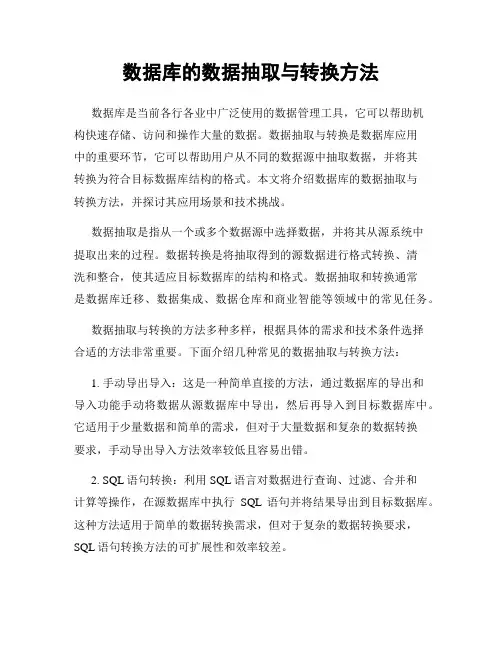
数据库的数据抽取与转换方法数据库是当前各行各业中广泛使用的数据管理工具,它可以帮助机构快速存储、访问和操作大量的数据。
数据抽取与转换是数据库应用中的重要环节,它可以帮助用户从不同的数据源中抽取数据,并将其转换为符合目标数据库结构的格式。
本文将介绍数据库的数据抽取与转换方法,并探讨其应用场景和技术挑战。
数据抽取是指从一个或多个数据源中选择数据,并将其从源系统中提取出来的过程。
数据转换是将抽取得到的源数据进行格式转换、清洗和整合,使其适应目标数据库的结构和格式。
数据抽取和转换通常是数据库迁移、数据集成、数据仓库和商业智能等领域中的常见任务。
数据抽取与转换的方法多种多样,根据具体的需求和技术条件选择合适的方法非常重要。
下面介绍几种常见的数据抽取与转换方法:1. 手动导出导入:这是一种简单直接的方法,通过数据库的导出和导入功能手动将数据从源数据库中导出,然后再导入到目标数据库中。
它适用于少量数据和简单的需求,但对于大量数据和复杂的数据转换要求,手动导出导入方法效率较低且容易出错。
2. SQL语句转换:利用SQL语言对数据进行查询、过滤、合并和计算等操作,在源数据库中执行SQL语句并将结果导出到目标数据库。
这种方法适用于简单的数据转换需求,但对于复杂的数据转换要求,SQL语句转换方法的可扩展性和效率较差。
3. ETL工具:ETL(Extract, Transform, Load)是一种常见的数据抽取与转换工具。
它通过定义数据抽取规则、转换规则和加载规则,自动地从源数据库中抽取数据,经过转换处理后加载到目标数据库中。
ETL工具通常包含图形化的用户界面,便于用户配置数据流程和转换规则。
ETL工具具有较高的效率和灵活性,可适应各种数据抽取和转换需求。
4. 数据同步工具:数据同步工具可以实现数据库之间的实时数据同步。
它通过监控源数据库的变化,并将变化的数据实时同步到目标数据库中。
数据同步工具往往具有较高的性能和稳定性,适合于需要频繁更新的数据抽取和转换需求。

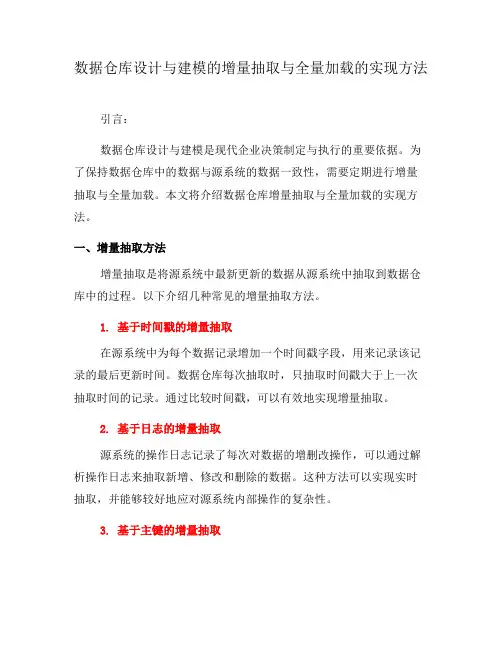
数据仓库设计与建模的增量抽取与全量加载的实现方法引言:数据仓库设计与建模是现代企业决策制定与执行的重要依据。
为了保持数据仓库中的数据与源系统的数据一致性,需要定期进行增量抽取与全量加载。
本文将介绍数据仓库增量抽取与全量加载的实现方法。
一、增量抽取方法增量抽取是将源系统中最新更新的数据从源系统中抽取到数据仓库中的过程。
以下介绍几种常见的增量抽取方法。
1. 基于时间戳的增量抽取在源系统中为每个数据记录增加一个时间戳字段,用来记录该记录的最后更新时间。
数据仓库每次抽取时,只抽取时间戳大于上一次抽取时间的记录。
通过比较时间戳,可以有效地实现增量抽取。
2. 基于日志的增量抽取源系统的操作日志记录了每次对数据的增删改操作,可以通过解析操作日志来抽取新增、修改和删除的数据。
这种方法可以实现实时抽取,并能够较好地应对源系统内部操作的复杂性。
3. 基于主键的增量抽取每个数据记录在源系统中都有一个唯一的主键,可以将主键与数据仓库中的对应记录进行比较,从而找到新增或修改的数据。
这种方法简单可靠,但对于大数据量的源系统可能存在性能问题。
二、全量加载方法全量加载是将数据仓库中的数据与源系统的数据完全同步的过程。
以下介绍几种常见的全量加载方法。
1. 定期全量加载根据需求设定一个固定的时间间隔,如每天凌晨,将源系统中的所有数据抽取到数据仓库中。
这种方法简单易行,但可能对源系统造成较大的负载。
2. 增量全量加载每次增量抽取完毕后,将抽取到的数据与数据仓库中的数据进行比较,找到源系统中已经删除的数据,并将其从数据仓库中删除。
然后将增量抽取到的数据与数据仓库中的数据进行合并,实现数据的完全同步。
三、增量抽取与全量加载的实践经验在实际应用中,为了保证数据仓库的准确性和及时性,需要结合具体情况选择合适的增量抽取与全量加载方法。
以下是一些实践经验供参考。
1. 精细化的增量抽取根据业务需求的不同,可以将增量抽取的粒度设置得更细。
例如,可以根据不同的业务规则设定增量抽取时所考虑的时间窗口,从而只抽取有业务影响的数据,减少不必要的开销。
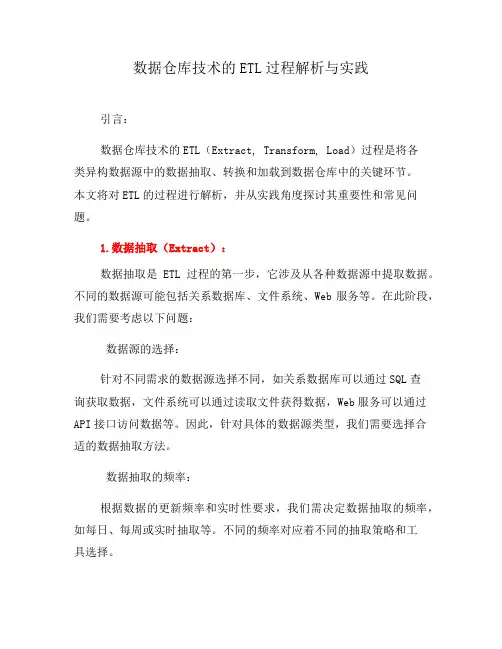
数据仓库技术的ETL过程解析与实践引言:数据仓库技术的ETL(Extract, Transform, Load)过程是将各类异构数据源中的数据抽取、转换和加载到数据仓库中的关键环节。
本文将对ETL的过程进行解析,并从实践角度探讨其重要性和常见问题。
1.数据抽取(Extract):数据抽取是ETL过程的第一步,它涉及从各种数据源中提取数据。
不同的数据源可能包括关系数据库、文件系统、Web服务等。
在此阶段,我们需要考虑以下问题:数据源的选择:针对不同需求的数据源选择不同,如关系数据库可以通过SQL查询获取数据,文件系统可以通过读取文件获得数据,Web服务可以通过API接口访问数据等。
因此,针对具体的数据源类型,我们需要选择合适的数据抽取方法。
数据抽取的频率:根据数据的更新频率和实时性要求,我们需决定数据抽取的频率,如每日、每周或实时抽取等。
不同的频率对应着不同的抽取策略和工具选择。
2.数据转换(Transform):数据转换是ETL过程的核心环节,它负责将抽取到的数据进行清洗、规范化、集成和聚合等处理。
在数据转换阶段,我们需要重点关注以下问题:数据清洗:数据清洗通常包括去除重复值、处理缺失值、校验数据完整性、规范化数据格式等。
通过数据清洗,我们可以提高数据质量和一致性,保证后续分析的准确性。
数据规范化:数据规范化是将数据转换为统一的格式和结构,以适应数据仓库中的模式。
这包括数据类型转换、字段命名统一、数据单位标准化等操作,以确保数据的一致性和可比性。
数据集成:在数据集成过程中,我们需要将来自不同数据源的数据进行合并和关联,以获得更全面的视图。
这可能涉及到数据匹配、关系建模和数据合并等操作。
数据聚合:数据聚合是将细粒度的数据聚集为更高层次的概要数据,以提供更高级别的分析。
通过聚合操作,可以减少数据存储和处理的复杂性,同时加速查询和分析过程。
3.数据加载(Load):数据加载是ETL过程的最后一步,它将经过抽取和转换的数据加载到数据仓库中,以供后续的分析和报表生成。
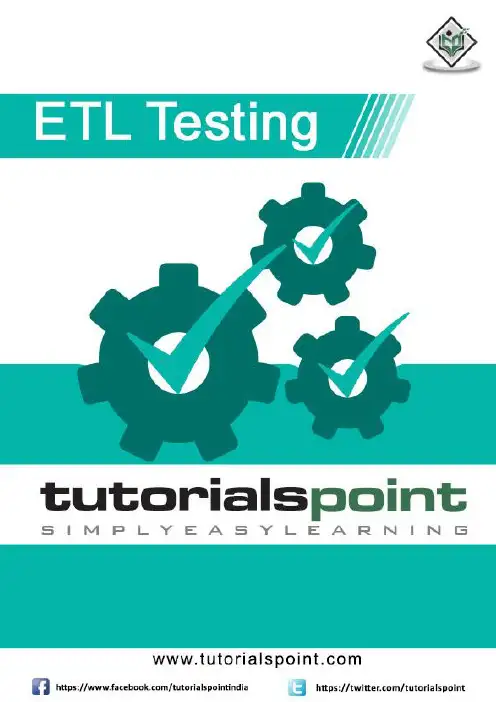
About the T utorialAn ETL tool extracts the data from all these heterogeneous data sources, transforms the data (like applying calculations, joining fields, keys, removing incorrect data fields, etc.), and loads it into a Data Warehouse. This is an introductory tutorial that explains all the fundamentals of ETL testing.AudienceThis tutorial has been designed for all those readers who want to learn the basics of ETL testing. It is especially going to be useful for all those software testing professionals who are required to perform data analysis to extract relevant information from a database. PrerequisitesWe assume the readers of this tutorial have hands-on experience of handling a database using SQL queries. In addition, it is going to help if the readers have an elementary knowledge of data warehousing concepts.Disclaimer & CopyrightCopyright 2015 by Tutorials Point (I) Pvt. Ltd.All the content and graphics published in this e-book are the property of Tutorials Point (I) Pvt. Ltd. The user of this e-book is prohibited to reuse, retain, copy, distribute or republish any contents or a part of contents of this e-book in any manner without written consent of the publisher.We strive to update the contents of our website and tutorials as timely and as precisely as possible, however, the contents may contain inaccuracies or errors. Tutorials Point (I) Pvt. Ltd. provides no guarantee regarding the accuracy, timeliness or completeness of our website or its contents including this tutorial. If you discover any errors on our websiteorinthistutorial,******************************************iT able of ContentsAbout the Tutorial (i)Audience (i)Prerequisites (i)Disclaimer & Copyright (i)Table of Contents .................................................................................................................................... i i 1.ETL – INTRODUCTION . (1)Difference between ETL and BI Tools (1)ETL Process (2)ETL Tool Function (3)2.ETL TESTING – TASKS (4)3.ETL VS DATABASE TESTING (5)4.ETL TESTING – CATEGORIES (7)5.ETL TESTING – CHALLENGES (9)6.ETL – TESTER'S ROLES (10)7.ETL TESTING – TECHNIQUES (12)8.ETL TESTING – PROCESS (15)9.ETL TESTING – SCENARIOS (TEST CASES) (16)10.ETL TESTING – PERFORMANCE (19)11.ETL TESTING – SCALABILITY (20)12.ETL TESTING – DATA ACCURACY (21)13.ETL TESTING – METADATA (22)ii14.ETL TESTING – DATA TRANSFORMATIONS (23)15.ETL TESTING – DATA QUALITY (24)16.ETL TESTING – DATA COMPLETENESS (25)17.ETL TESTING – BACKUP RECOVERY (26)18.ETL TESTING – AUTOMATION (27)19.ETL TESTING – BEST PRACTICES (28)20.ETL TESTING – INTERVIEW QUESTIONS (30)iiiETL Testing 1The data in a Data Warehouse system is loaded with an ETL (Extract, Transform, Load) tool. As the name suggests, it performs the following three operations: ∙Extracts the data from your transactional system which can be an Oracle, Microsoft, or any other relational database, ∙Transforms the data by performing data cleansing operations, and then ∙ Loads the data into the OLAP data Warehouse.You can also extract data from flat files like spreadsheets and CSV files using an ETL tool and load it into an OLAP data warehouse for data analysis and reporting. Let us take an example to understand it better.ExampleLet us assume there is a manufacturing company having multiple departments such as sales, HR, Material Management, EWM, etc. All these departments have separate databases which they use to maintain information w.r.t. their work and each database has a different technology, landscape, table names, columns, etc. Now, if the company wants to analyze historical data and generate reports, all the data from these data sources should be extracted and loaded into a Data Warehouse to save it for analytical work.An ETL tool extracts the data from all these heterogeneous data sources, transforms the data (like applying calculations, joining fields, keys, removing incorrect data fields, etc.), and loads it into a Data Warehouse. Later, you can use various Business Intelligence (BI) tools to generate meaningful reports, dashboards, and visualizations using this data. Difference between ETL and BI T oolsAn ETL tool is used to extract data from different data sources, transform the data, and load it into a DW system; however a BI tool is used to generate interactive and ad-hoc reports for end-users, dashboard for senior management, data visualizations for monthly, quarterly, and annual board meetings.The most common ETL tools include: SAP BO Data Services (BODS), Informatica – Power Center, Microsoft – SSIS, Oracle Data Integrator ODI, Talend Open Studio, Clover ETL Open source, etc.Some popular BI tools include: SAP Business Objects, SAP Lumira, IBM Cognos, JasperSoft, Microsoft BI Platform, Tableau, Oracle Business Intelligence Enterprise Edition, etc.1. ETL – IntroductionETL ProcessLet us now discuss in a little more detail the key steps involved in an ETL procedure –Extracting the DataIt involves extracting the data from different heterogeneous data sources. Data extraction from a transactional system varies as per the requirement and the ETL tool in use. It is normally done by running scheduled jobs in off-business hours like running jobs at night or over the weekend.Transforming the DataIt involves transforming the data into a suitable format that can be easily loaded into a DW system. Data transformation involves applying calculations, joins, and defining primary and foreign keys on the data. For example, if you want % of total revenue which is not in database, you will apply % formula in transformation and load the data. Similarly, if you have the first name and the last name of users in different columns, then you can apply a concatenate operation before loading the data. Some data do esn’t require any transformation; such data is known as direct move or pass through data. Data transformation also involves data correction and cleansing of data, removing incorrect data, incomplete data formation, and fixing data errors. It also includes data integrity and formatting incompatible data before loading it into a DW system. Loading the Data into a DW SystemIt involves loading the data into a DW system for analytical reporting and information. The target system can be a simple delimited flat file or a data warehouse.2ETL T ool FunctionA typical ETL tool-based data warehouse uses staging area, data integration, and access layers to perform its functions. It’s normally a 3-layer architecture.∙Staging Layer– The staging layer or staging database is used to store the data extracted from different source data systems.∙Data Integration Layer–The integration layer transforms the data from the staging layer and moves the data to a database, where the data is arranged into hierarchical groups, often called dimensions, and into facts and aggregate facts. The combination of facts and dimensions tables in a DW system is called a schema.∙Access Layer–The access layer is used by end-users to retrieve the data for analytical reporting and information.The following illustration shows how the three layers interact with each other.3ETL Testing4ETL testing is done before data is moved into a production data warehouse system. It is sometimes also called as table balancing or production reconciliation . It is different from database testing in terms of its scope and the steps to be taken to complete this. The main objective of ETL testing is to identify and mitigate data defects and general errors that occur prior to processing of data for analytical reporting. ETL Testing – Tasks to be PerformedHere is a list of the common tasks involved in ETL Testing –1. Understand the data to be used for reporting2. Review the Data Model3. Source to target mapping4. Data checks on source data5. Packages and schema validation6. Data verification in the target system7. Verification of data transformation calculations and aggregation rules8. Sample data comparison between the source and the target system9. Data integrity and quality checks in the target system10. Performance testing on data2. ETL Testing – TasksETL Testing 5Both ETL testing and database testing involve data validation, but they are not the same. ETL testing is normally performed on data in a data warehouse system, whereas database testing is commonly performed on transactional systems where the data comes from different applications into the transactional database.Here, we have highlighted the major differences between ETL testing and Database testing.ETL TestingETL testing involves the following operations:1. Validation of data movement from the source to the target system.2. Verification of data count in the source and the target system.3. Verifying data extraction, transformation as per requirement and expectation.4. Verifying if table relations – joins and keys – are preserved during the transformation.Common ETL testing tools include QuerySurge , Informatica , etc. Database TestingDatabase testing stresses more on data accuracy, correctness of data and valid values. It involves the following operations:1. Verifying if primary and foreign keys are maintained.2. Verifying if the columns in a table have valid data values.3. Verifying data accuracy in columns. Example : Number of months column shouldn’t have a value greater than 12.4. Verifying missing data in columns. Check if there are null columns which actually should have a valid value.Common database testing tools include Selenium , QTP , etc.3. ETL vs Database TestingETL TestingEnd of ebook previewIf you liked what you saw…Buy it from our store @ https://6。
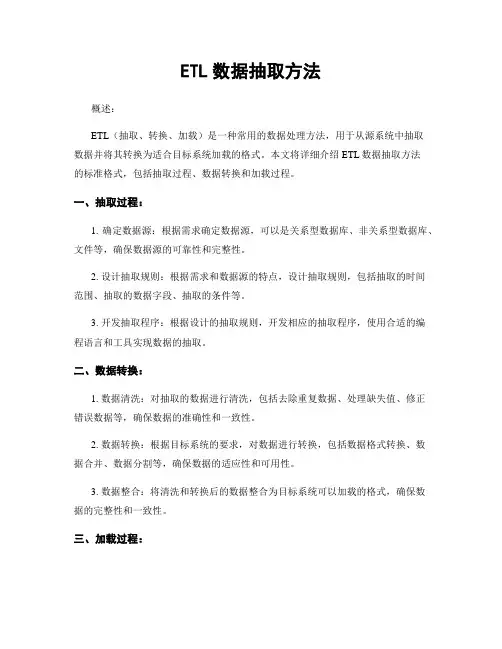
ETL数据抽取方法概述:ETL(抽取、转换、加载)是一种常用的数据处理方法,用于从源系统中抽取数据并将其转换为适合目标系统加载的格式。
本文将详细介绍ETL数据抽取方法的标准格式,包括抽取过程、数据转换和加载过程。
一、抽取过程:1. 确定数据源:根据需求确定数据源,可以是关系型数据库、非关系型数据库、文件等,确保数据源的可靠性和完整性。
2. 设计抽取规则:根据需求和数据源的特点,设计抽取规则,包括抽取的时间范围、抽取的数据字段、抽取的条件等。
3. 开发抽取程序:根据设计的抽取规则,开发相应的抽取程序,使用合适的编程语言和工具实现数据的抽取。
二、数据转换:1. 数据清洗:对抽取的数据进行清洗,包括去除重复数据、处理缺失值、修正错误数据等,确保数据的准确性和一致性。
2. 数据转换:根据目标系统的要求,对数据进行转换,包括数据格式转换、数据合并、数据分割等,确保数据的适应性和可用性。
3. 数据整合:将清洗和转换后的数据整合为目标系统可以加载的格式,确保数据的完整性和一致性。
三、加载过程:1. 目标系统准备:确保目标系统的数据库结构和表结构与加载的数据匹配,包括创建表、定义字段等。
2. 数据加载:将经过抽取和转换的数据加载到目标系统中,可以使用数据库的插入语句、数据导入工具等方式进行加载。
3. 数据校验:对加载后的数据进行校验,比对源数据和目标数据的一致性,确保数据加载的准确性和完整性。
四、数据质量监控:1. 设计数据质量指标:根据业务需求和数据特点,设计相应的数据质量指标,包括数据完整性、数据准确性、数据一致性等。
2. 实施数据质量监控:通过定期抽样、数据比对等方式,对抽取、转换和加载的数据进行监控,及时发现和解决数据质量问题。
3. 数据质量报告:根据数据质量监控的结果,生成数据质量报告,向相关人员反馈数据质量情况,提供决策依据。
五、性能优化:1. 数据抽取性能优化:通过合理的抽取规则设计、增量抽取等方式,提高数据抽取的效率和速度。
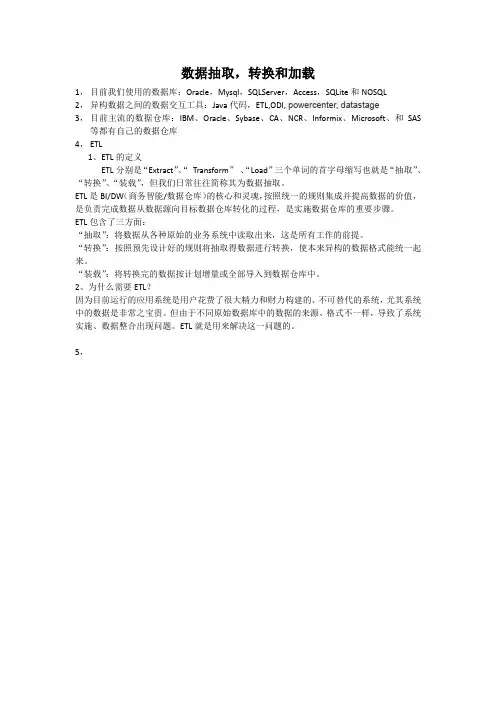
数据抽取,转换和加载
1,目前我们使用的数据库:Oracle,Mysql,SQLServer,Access,SQLite和NOSQL
2,异构数据之间的数据交互工具:Java代码,ETL,ODI,powercenter,datastage
3,目前主流的数据仓库:IBM、Oracle、Sybase、CA、NCR、Informix、Microsoft、和SAS 等都有自己的数据仓库
4,ETL
1、ETL的定义
ETL分别是“Extract”、“Transform”、“Load”三个单词的首字母缩写也就是“抽取”、“转换”、“装载”,但我们日常往往简称其为数据抽取。
ETL是BI/DW(商务智能/数据仓库)的核心和灵魂,按照统一的规则集成并提高数据的价值,是负责完成数据从数据源向目标数据仓库转化的过程,是实施数据仓库的重要步骤。
ETL包含了三方面:
“抽取”:将数据从各种原始的业务系统中读取出来,这是所有工作的前提。
“转换”:按照预先设计好的规则将抽取得数据进行转换,使本来异构的数据格式能统一起来。
“装载”:将转换完的数据按计划增量或全部导入到数据仓库中。
2、为什么需要ETL?
因为目前运行的应用系统是用户花费了很大精力和财力构建的、不可替代的系统,尤其系统中的数据是非常之宝贵。
但由于不同原始数据库中的数据的来源、格式不一样,导致了系统实施、数据整合出现问题。
ETL就是用来解决这一问题的。
5,。
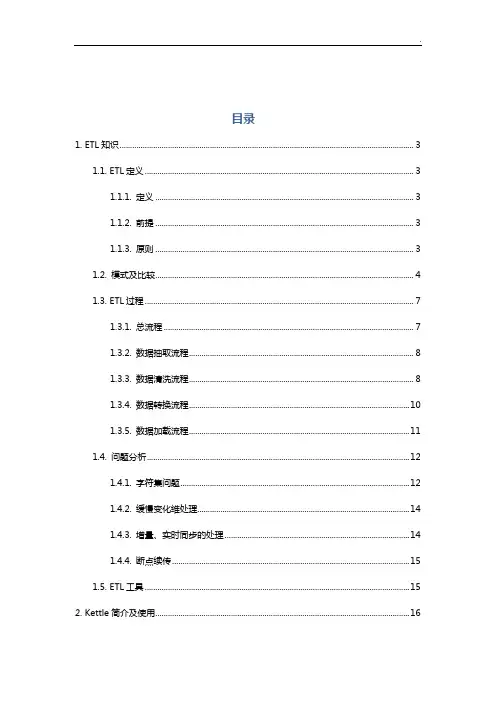
目录1. ETL知识 (3)1.1. ETL定义 (3)1.1.1. 定义 (3)1.1.2. 前提 (3)1.1.3. 原则 (3)1.2. 模式及比较 (4)1.3. ETL过程 (7)1.3.1. 总流程 (7)1.3.2. 数据抽取流程 (8)1.3.3. 数据清洗流程 (8)1.3.4. 数据转换流程 (10)1.3.5. 数据加载流程 (11)1.4. 问题分析 (12)1.4.1. 字符集问题 (12)1.4.2. 缓慢变化维处理 (14)1.4.3. 增量、实时同步的处理 (14)1.4.4. 断点续传 (15)1.5. ETL工具 (15)2. Kettle简介及使用 (16)2.1. 什么Kettle? (16)2.2. 下载及安装Kettle (17)2.3. Kettle简单例子 (19)2.3.1. 启动Kettle (19)2.3.2. 创建transformation过程 (20)2.3.3. 创建job过程 (41)2.3.4. 命令行运行ktr和kjb (45)1.ETL知识1.1.ETL定义1.1.1.定义●定义:数据的抽取(Extract)、转换(Transform)、装载(Load)的过程。
●目标:数据优化。
以最小代价(包括对日常操作的影响和对技能的要求) 将针对日常业务操作的数据转化为针对数据仓库而存储的决策支持型数据。
1.1.2.前提●确定ETL范围通过对目标表信息的收集,确定ETL的范围●选择ETL工具考虑资金运行的平台、对源和目标的支持程度、可编程的灵活性、对源数据变化的监测、数据处理时间的控制、管理和调度功能、对异常情况的处理●确定解决方案抽取分析、变化数据的捕获、目标表的刷新策略、数据的转换及数据验证1.1.3.原则●应尽量利用数据中转区对运营数据进行预处理。
保证数据的安全性、集成与加载的高效性。
●ETL的过程应是主动“拉取”,而不是从内部“推送”,其可控性将大为增强。
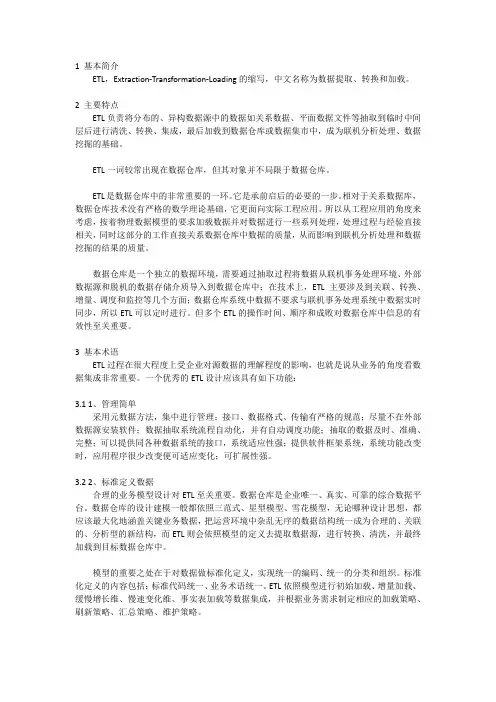
1 基本简介ETL,Extraction-Transformation-Loading的缩写,中文名称为数据提取、转换和加载。
2 主要特点ETL负责将分布的、异构数据源中的数据如关系数据、平面数据文件等抽取到临时中间层后进行清洗、转换、集成,最后加载到数据仓库或数据集市中,成为联机分析处理、数据挖掘的基础。
ETL一词较常出现在数据仓库,但其对象并不局限于数据仓库。
ETL是数据仓库中的非常重要的一环。
它是承前启后的必要的一步。
相对于关系数据库,数据仓库技术没有严格的数学理论基础,它更面向实际工程应用。
所以从工程应用的角度来考虑,按着物理数据模型的要求加载数据并对数据进行一些系列处理,处理过程与经验直接相关,同时这部分的工作直接关系数据仓库中数据的质量,从而影响到联机分析处理和数据挖掘的结果的质量。
数据仓库是一个独立的数据环境,需要通过抽取过程将数据从联机事务处理环境、外部数据源和脱机的数据存储介质导入到数据仓库中;在技术上,ETL主要涉及到关联、转换、增量、调度和监控等几个方面;数据仓库系统中数据不要求与联机事务处理系统中数据实时同步,所以ETL可以定时进行。
但多个ETL的操作时间、顺序和成败对数据仓库中信息的有效性至关重要。
3 基本术语ETL过程在很大程度上受企业对源数据的理解程度的影响,也就是说从业务的角度看数据集成非常重要。
一个优秀的ETL设计应该具有如下功能:3.1 1、管理简单采用元数据方法,集中进行管理;接口、数据格式、传输有严格的规范;尽量不在外部数据源安装软件;数据抽取系统流程自动化,并有自动调度功能;抽取的数据及时、准确、完整;可以提供同各种数据系统的接口,系统适应性强;提供软件框架系统,系统功能改变时,应用程序很少改变便可适应变化;可扩展性强。
3.2 2、标准定义数据合理的业务模型设计对ETL至关重要。
数据仓库是企业唯一、真实、可靠的综合数据平台。
数据仓库的设计建模一般都依照三范式、星型模型、雪花模型,无论哪种设计思想,都应该最大化地涵盖关键业务数据,把运营环境中杂乱无序的数据结构统一成为合理的、关联的、分析型的新结构,而ETL则会依照模型的定义去提取数据源,进行转换、清洗,并最终加载到目标数据仓库中。

目录ETL简介 (1)ETL抽取方案 (2)1、数据抽取 (2)2、数据转换与加工 (6)3、数据装载 (7)4、时间戳方式 ................................................................................................................... 错误!未定义书签。
5、全量删除插入方式......................................................................................................... 错误!未定义书签。
6、全量比对方式................................................................................................................ 错误!未定义书签。
ETL简介数据集成就是把不同来源、格式与特点得数据在逻辑上或物理上有机地集中,从而提供全面得数据共享,就是企业商务智能、数据仓库系统得重要组成部分。
ETL 就是企业数据集成得主要解决方案。
ETL 中三个字母分别代表得就是Extract、Transform、Load,即抽取、转换、加载。
(1)数据抽取:从源数据源系统抽取目得数据源系统需要得数据;(2)数据转换:将从源数据源获取得数据按照业务需求,转换成目得数据源要求得形式,并对错误、不一致得数据进行清洗与加工;(3)数据加载:将转换后得数据装载到目得数据源。
ETL 作为构建数据仓库得一个环节,负责将分布得、异构数据源中得数据如关系数据、平面数据文件等抽取到临时中间层后进行清洗、转换、集成,最后加载到数据仓库或数据集市中,成为联机分析处理、数据图1ETL抽取方案ETL 过程中得主要环节就就是数据抽取、数据转换与加工、数据装载。
数据仓库ETL流程数据仓库ETL流程是指将来源于多个不同数据源的数据进行抽取(Extract)、转换(Transform)、加载(Load)的过程。
该流程旨在将原始的、分散的数据整合到一个统一的、结构化的数据仓库中,以支持企业的决策分析和业务需求。
一、数据抽取(Extract)数据抽取是指从各个数据源中提取数据的过程。
在数据抽取阶段中,需要根据具体的业务需求来选择合适的抽取策略,包括完全抽取和增量抽取两种方式。
完全抽取是指每次都将整个源数据集抽取到数据仓库中,适用于数据量较小、更新频率较低的情况;增量抽取则是只将源数据中新增或更新的部分抽取到数据仓库中,适用于数据量大、更新频率高的情况。
在实施数据抽取时,可以使用多种技术和工具,如SQL查询、API接口、文件导入等。
根据具体的数据源类型和数据结构,选择合适的数据抽取方法,并确保数据的准确性和完整性。
二、数据转换(Transform)数据转换是指对抽取的数据进行清洗、处理和转换的过程。
在数据转换阶段中,需要对数据进行格式转换、数据清洗、数据集成和数据规则验证等操作,以确保数据的一致性和质量。
数据格式转换是将抽取的数据转换成适合数据仓库的统一格式,通常使用数据转换工具实现,如ETL工具或编程语言。
数据清洗是指对数据进行去重、清除异常值、填充缺失值等操作,以提高数据的准确性和可用性。
数据集成是将来自不同数据源的数据进行整合,消除重复数据和冗余数据,实现一致的数据视图。
数据规则验证是根据预先定义的规则,对数据进行验证和校验,确保数据符合规范和业务需求。
三、数据加载(Load)数据加载是指将转换后的数据加载到数据仓库中的过程。
数据加载可以分为全量加载和增量加载两种方式,类似于数据抽取阶段的完全抽取和增量抽取。
全量加载是指每次都将整个数据集加载到数据仓库中,适用于数据量较小、更新频率较低的情况;增量加载则是只将变化的数据加载到数据仓库中,适用于数据量大、更新频率高的情况。